Local Column
COLUMN

A wide variety of fishes seen in Iriomote Island
目次
Iriomote Island, the last unexplored island
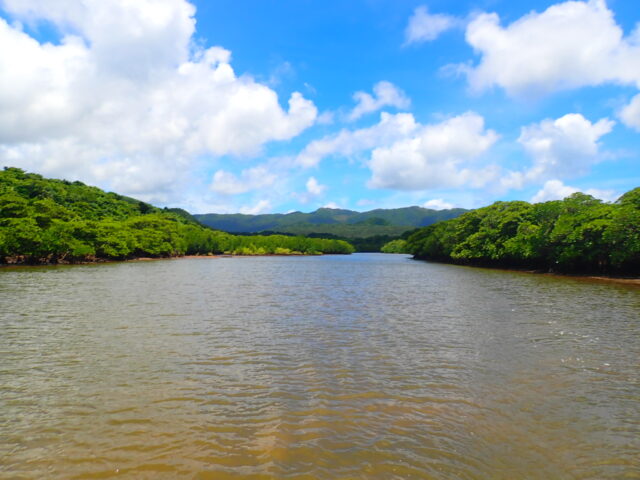
Iriomote Island is sometimes called "the last unexplored region" or "the Galapagos of the East.
This is because Iriomote Island is rich in untouched wilderness and has its own unique flora and fauna.
For example, Iriomote Island has a natural environment with the following characteristics.
Iriomote Island will have about 90% of the entire island covered by subtropical virgin forest.
There are about 40 rivers of various sizes on the island, and mangroves grow near the mouths of most of them, giving the island a rich national atmosphere.
It is also considered a place of academic value, with more than 10 nationally designated special natural monuments, including the Iriomote wildcat.
Because of this natural environment and the precious creatures that inhabit it, the entire island is designated as part of the Iriomote-Ishigaki National Park.
How to swim with fishes in Iriomote Island?
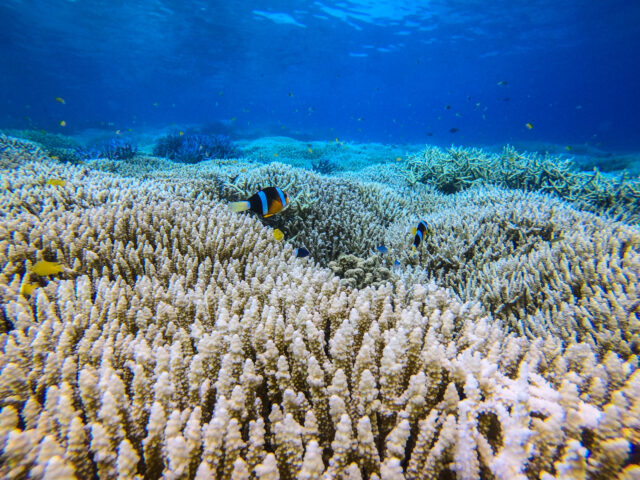
Iriomote Island is surrounded by crystal clear waters.
The surrounding waters will be home to a variety of tropical fish.
One of the charms of Iriomote Island is that you can see the swimming form and ecology of these fish right in front of your eyes and swim with them.
We will introduce in turn the characteristics of the sea of Iriomote Island, such as coral reefs, how to swim with fishes, what kind of fishes you can encounter, and typical types of fishes.
Coral in the waters between Ishigaki Island and
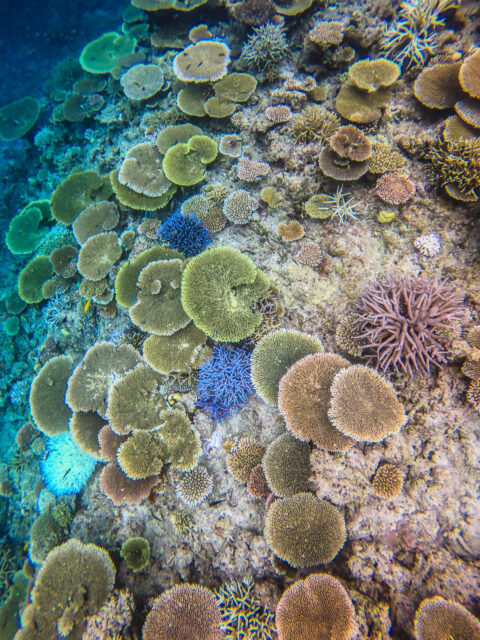
The sea area between Iriomote Island and Ishigaki Island has the largest coral reef area in Japan.
It is said that nearly 400 species of corals live here, and the diversity of the coral species here is far greater than any other area in the area.
This area is also designated as part of the Iriomote-Ishigaki National Park.
There are three ways to enjoy this fascinating ocean, which we will introduce one by one below.
Snorkeling Tour
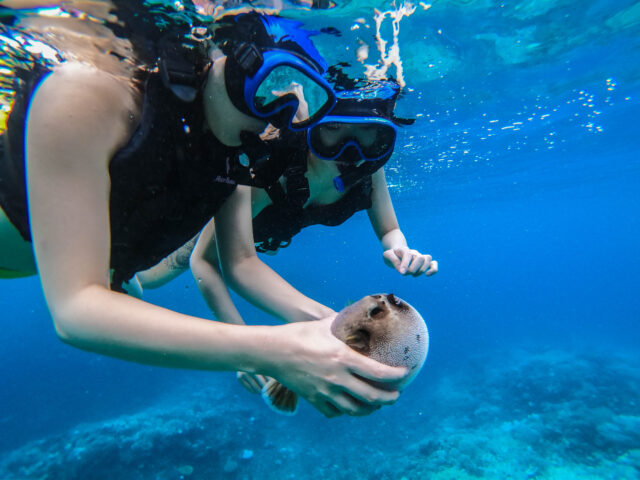
First is a snorkeling tour.
No special license is required to enjoy snorkeling, so anyone can enjoy it.
All you need is a mask (underwater glasses), a snorkel (a device that you hold in your mouth to let air through), and fins.
The easiest way to enjoy the sea of Iriomote Island is to float on the surface of the sea with these tools and see the underwater.
Even though it is easy and enjoyable, it is safe to have a guide who is familiar with the area and can help you avoid danger beforehand.
For this purpose, there are companies and other organizations in the area that offer snorkeling tours.
Enjoy a safe snorkeling tour with a guide who is familiar with the local points of interest.
Diving Tours
Diving is recommended if you want to enjoy the sea of Iriomote Island with many tropical fishes and many kinds of corals.
Diving allows you to go deeper into the ocean than snorkeling does, and this gives you a wider range of movement and a greater variety of fish to encounter.
Visitors can also enjoy the colors of the sea itself, which change with depth.
As a rule, diving requires a license, unlike snorkeling.
For those who do not have a diving license but would like to try diving, there is the experience diving method.
Experience diving is for inexperienced divers, and the instructor who dives with you will help you operate the equipment and manage safety.
Therefore, it is not possible to move freely underwater or dive very deep, but the fun and excitement of diving can be fully experienced.
If you would like to obtain a diving license because you have gone through the trouble, there are plans that allow you to obtain a license, so please give it a try.
After three days of training (including practical skills) and passing the exam, the license can be obtained.
Although you will need some extra time for your stay, acquiring a diving license is also a luxurious way to spend your time in Iriomote Island.
swim privately
The last option is to swim on your own without a tour.
The best part is that you can swim at your leisure without a guide.
The equipment necessary for snorkeling is readily available, and we recommend that you have the snorkeling equipment previously mentioned for individual swimmers.
If you want to enjoy the clear and beautiful ocean, you should use a mask because it allows you to see clearly underwater and fins make it easier and faster to move around in the ocean.
When swimming privately, please take care of your own safety and do not overdo it.
Fish found on Iriomote Island
What kind of fish can we see in Iriomote Island?
Here are some typical fish.
clownfish (Balistoides conspicillum)
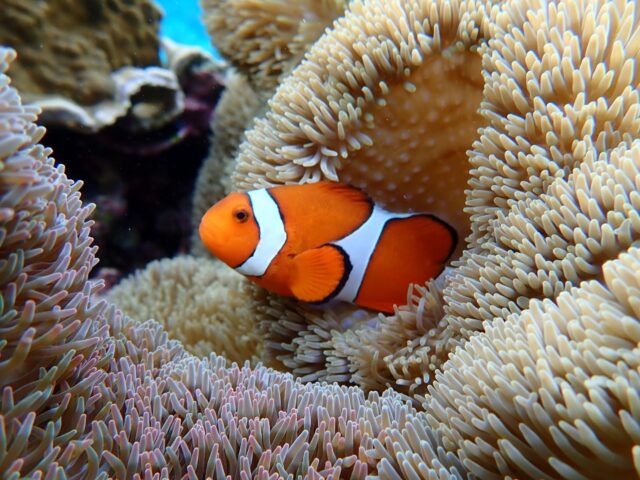
The body is a beautiful orange ground color with three thick white bands.
You may have seen them in sea anemones on TV or in other images.
It is a cute fish, about 8 cm in length.
It is the most likely fish you will encounter when diving.
yellowtail amberjack (species of fish, Seriola lalandi)
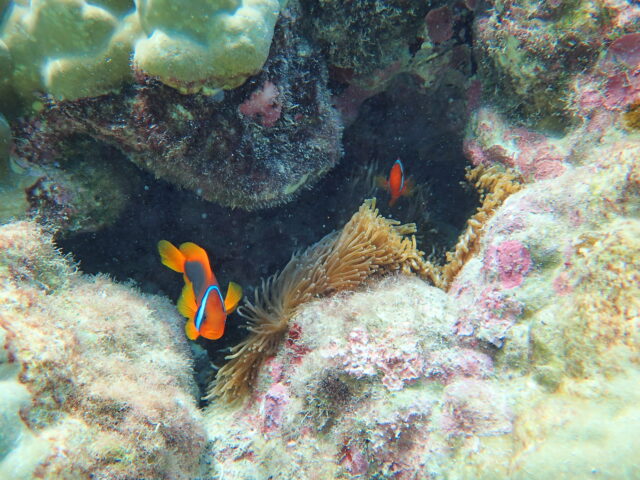
This is another species of clownfish that lives with anemones.
The size of the fish is about the same as the clownfish, but the body of the fish is more similar to the clownfish and more vertical than the clownfish, unlike the clownfish, which is horizontal.
Because of their similar coloration, they are often mistaken for clownfish.
sapphire devil (Chrysiptera cyanea, damselfish from the Indo-West Pacific)
This bright blue fish is most commonly found in shallow tropical coral reefs.
Since they are about 6 cm in length and easy to keep, many of you have probably seen them in aquariums where saltwater tropical fish are kept.
scissortail sergeant (Abudefduf sexfasciatus)

This species of spiny dogfish is 15 to 20 cm in length and is characterized by the five black vertical stripes on its body.
This fish is found in relatively shallow water and is commonly found at depths of about 20 meters.
It is distributed in temperate to tropical seas, and in Japan it is found in seas south of Shizuoka Prefecture.
blue-green chromis
This fish is also a member of the spiny dogfish family and is about 8 cm long.
This beautiful fish has a greenish blue body color that changes its color to various shades of blue depending on how the light hits it.
They live in schools on coral reefs in shallow water.
moorish idol (Zanclus cornutus, species of Indo-Pacific perciform fish)

As it grows, thorns appear on both sides of the eyes, which look like horns, hence the name "horned".
Its body is longer vertically than horizontally, with long thorns protruding from its back.
They live on coral reefs and rocky reefs.
sixbar wrasse (Thalassoma hardwicke)
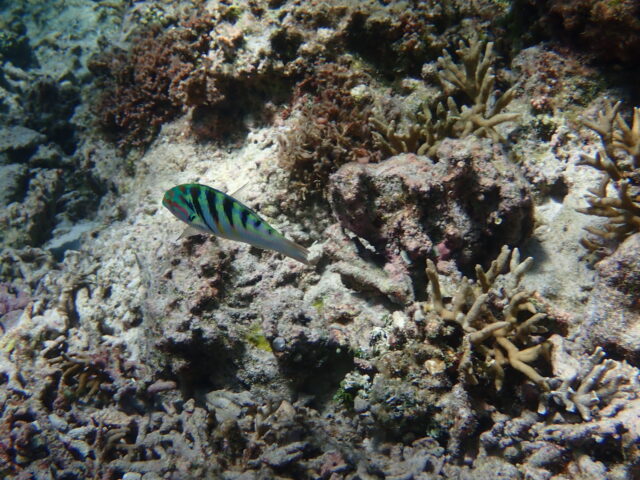
As its name suggests, it is a member of the Vera family.
Bella is brightly colored and beautiful to look at.
Like the debase damselfish, it lives in shallow coral reefs.
pinktail durgon (durgeon) (triggerfish) (Melicthys vidua)

They inhabit coral reefs and the surrounding sandy and rocky reefs.
At about 20 cm in length, it is not a large fish, but its character is rough and needs attention.
If they see you are near their nest, i.e., intruding on their territory, they will attack you.
They are especially aggressive during the breeding season (early summer to summer).
They will not attack you if you do not invade their territory, so as long as you do not approach them carelessly, they will not attack you.
threadfin butterflyfish (Chaetodon auriga, species of the Indo-Pacific)
These fish are common in the waters of Okinawa.
It is about 20 cm long and has an orange coloration near the tail.
They live around coral reefs and are omnivores.
For this reason, breeding and feeding them is considered relatively easy.
vagabond butterflyfish (Chaetodon vagabundus, species of the Indo-Pacific)
This is another popular fish in the Okinawan sea.
They are found on coral reefs and rocky reefs, but they do not live in groups, but rather alone or in pairs.
The fish is about 20 cm long and is an omnivore, making it easy to keep.
Sea creatures other than fish that can be seen in Iriomote Island
In the sea of Iriomote Island, various creatures besides fish inhabit, among which sea turtles and manta rays are introduced as representative creatures.
sea turtle
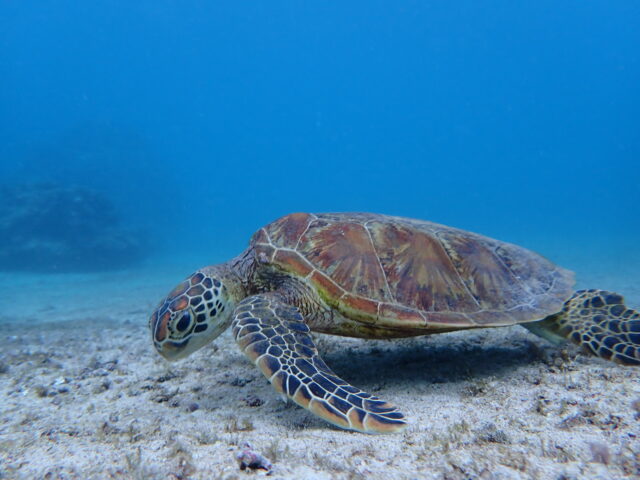
Three species of sea turtles will be inhabiting the sea around Iriomote Island: green turtles, loggerhead turtles, and tairai.
Currently, there are seven species of sea turtles living in the world, so you can see almost half of them on Iriomote Island.
manta ray
Mantas are members of the ray family.
It is considered the largest species of ray.
Their large size and majestic swimming form make them very popular among divers.
It is easy to tell them apart because of the black spots on their bellies.
Dangerous Sea Creatures in Iriomote Island
To enjoy the sea of Iriomote Island, it is important to know dangerous creatures in advance.
And if you are a victim, understanding how to deal with the damage can help minimize it.
Here are some typical dangerous creatures and what to do if you are a victim.
northern sea nettle (Chrysaora melanaster)
These jellyfish appear in shallow areas of the ocean from May to October.
Its tentacles are highly toxic and it is considered one of the most damaging marine danger creatures in Okinawa.
Stings cause severe pain and should be treated immediately.
What to do if you are a victim
If you are stung, remain calm and get out of the water first.
Never rub the sting.
Then, remove the tentacles by pouring plenty of vinegar on the sting.
Then cool the sting with cold water and seek medical attention.
Portuguese man-of-war (Physalia physalis)
The bonefish is a type of jellyfish, characterized by a bright blue floating bag.
Its tentacles are highly venomous, and its sting is said to cause electric shock-like pain.
What to do if you are a victim
If you are stung, do not panic, remain calm, and get out of the water first.
Never rub the sting site.
Apply plenty of seawater, remove the tentacles, cool them with cold water, etc., and seek medical attention.
red lionfish (Pterois volitans)
One species of minnows, they are relatively large, some reaching up to 35 cm in length.
It looks gorgeous and beautiful with its large dorsal and pectoral fins, but each has its own thorn, which causes severe pain when it stings.
What to do if you are a victim
If sting thorns remain, rinse well with water.
Soaking in hot water above 45°C (45°F) will slightly ease the toxicity and alleviate some of the pain.
Thorns can cause deep wounds, and it is important to seek prompt medical attention.
stonefish
It is one of the species of octopuses with a poisonous dorsal fin, and is said to be the most toxic of all the octopuses.
Onidaruma gobies are tricky because they mimic and hide in rocky areas, making them difficult to see.
What to do if you are a victim
Please calm down and get out of the water first.
Rinse the sting site well with water and remove any remaining thorns.
As with scorpionfish stings, soaking the sting in hot water of 45°C or higher will relieve the toxicity and alleviate some of the pain.
After such first aid measures are completed, seek medical attention immediately.
blotched snakehead (species of fish, Channa maculata)
This is a striped looking sea snake.
It is believed that as long as you do not touch them, they will not attack you.
The most certain way to avoid damage is to stay away.
What to do if you are a victim
Quickly get out of the water and tie up the area above the bite, near the heart, tightly so that the venom does not circulate throughout the body.
Then squeeze the venom out of the bite.
After taking these first aid measures, it is necessary to seek medical attention as soon as possible.
crown-of-thorns starfish (Acanthaster planci)
These are large starfish that live on coral reefs.
It has thorns all over its body, and the thorns are poisonous.
What to do if you are a victim
Immediately get out of the water and remove any visible thorns.
The pain can be alleviated by placing the sting in hot water of about 45°C (45°F).
Seek medical attention as soon as possible.
blue-ringed octopus (esp. one species, the blue-lined octopus, Hapalochlaena fasciata)
This small octopus, about 10 cm long, has a leopard-like pattern that appears on its body surface when it is stimulated.
Their saliva is poisonous and their bite is very dangerous.
Although they are considered docile and do not attack on their own, they become aggressive when they sense danger or are provoked.
What to do if you are a victim
Squeeze the venom out of the bite while running water over the bite.
Prompt medical attention is required.
To enjoy the sea of Iriomote Island safely
In order to safely enjoy the sea of Iriomote Island, it is important to have an approximate understanding of the sea of Iriomote Island.
In addition to that, the methods and preparations described below will help you enjoy the experience more safely.
Take tours as much as possible!
To enjoy the sea of Iriomote Island safely, it is recommended to join a tour.
The tour will be accompanied by guides and instructors who are familiar with the sea of Iriomote Island, so you can rest assured that you will be able to avoid common dangers by following their instructions.
They also take appropriate measures in the event of damage.
Do not touch marine life unnecessarily!
Even if you take a tour, the one thing you definitely want to follow is not to touch any living creatures.
Also, remember not to get too close unnecessarily.
Let's keep in mind how to deal with this!
No matter how careful you are, it is difficult to avoid damage altogether.
Therefore, be sure to keep in mind what to do in the event of damage.
This way, you can deal with the situation calmly and without panic.
summary
Iriomote Island is sometimes called the last unexplored region of Japan because of its unspoiled, naturally rich environment and uniquely evolved ecosystem.
Surrounded by crystal clear waters, it is ideal for marine activities.
There are several ways to swim with fish in the sea of Iriomote Island, such as snorkeling tours, diving tours, and private swimming.
There are some dangerous creatures in the sea, so it is recommended to take a tour as much as possible in order to be careful of these and enjoy the experience.

